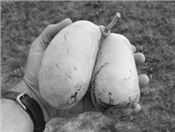Recently Named The Missouri State Fruit, PawPaws Are Good On The Tongue And In Landscapes
MARSHFIELD, MO.
Sometimes called the Ozark Banana, the pawpaw was recently declared the Missouri State Fruit by lawmakers.
This native Missouri fruit deserves the distinction according to Patrick Byers, field specialist in horticulture with University of Missouri Extension.
“The pawpaw is particularly common in the Ozarks,” said Byers.
Individuals can learn more at the Pawpaw Field Day planned for 1 p.m. to 5 p.m., Sept. 20 at the MU Southwest Center in Mount Vernon.
CHARACTERISTICS
Pawpaw trees favor moist, shady habitats. These locations include heavily wooded streams, in forest valleys or along the lower slopes of forested hills.
Pawpaw fruits can reach a length of five inches and a width of two inches. These somewhat oval-shaped fruits can weigh as much as 16 ounces and are one of the larger edible fruits native to the United States.
In southwest Missouri, pawpaw fruit ripens in September and early October.
According to Byers, the pawpaw makes a lovely small tree for the landscape.
“Be sure to plant two different cultivars to allow for cross-pollination,” said Byers. “Good cultivars include Sunflower, Shenandoah, Susquehanna, and Pennsylvania Gold.”
Each fruit contains 10-14 seeds that are roughly the size of lima beans.
EATING PAWPAWS
“Pick the fruit after it begins to soften. The fruit is perishable so enjoy it as soon as possible after harvest,” said Byers. “The fruit has a flesh texture reminiscent of firm custard, and a tropical flavor.”
The pawpaw can be enjoyed as fruit fresh, or in prepared in pudding, bread, cookies, ice cream or milkshakes. ∆

Sometimes called the Ozark Banana, the pawpaw was recently declared the Missouri State Fruit by lawmakers.

Each pawpaw fruit contains 10-14 seeds that are roughly the size of lima beans.
Photos credit: MU Extension